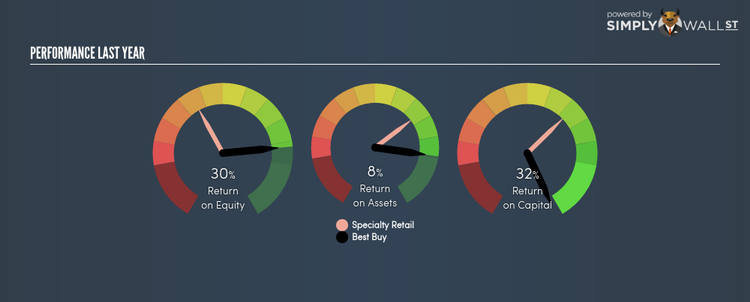How Best Buy Co Inc (NYSE:BBY) Delivered A Better ROE Than Its Industry

Best Buy Co Inc (NYSE:BBY) outperformed the Computer and Electronics Retail industry on the basis of its ROE – producing a higher 29.53% relative to the peer average of 11.39% over the past 12 months. While the impressive ratio tells us that BBY has made significant profits from little equity capital, ROE doesn’t tell us if BBY has borrowed debt to make this happen. We’ll take a closer look today at factors like financial leverage to determine whether BBY’s ROE is actually sustainable. Check out our latest analysis for Best Buy
Peeling the layers of ROE – trisecting a company’s profitability
Return on Equity (ROE) weighs Best Buy’s profit against the level of its shareholders’ equity. An ROE of 29.53% implies $0.3 returned on every $1 invested. In most cases, a higher ROE is preferred; however, there are many other factors we must consider prior to making any investment decisions.
Return on Equity = Net Profit ÷ Shareholders Equity
ROE is measured against cost of equity in order to determine the efficiency of Best Buy’s equity capital deployed. Its cost of equity is 8.63%. Since Best Buy’s return covers its cost in excess of 20.90%, its use of equity capital is efficient and likely to be sustainable. Simply put, Best Buy pays less for its capital than what it generates in return. ROE can be split up into three useful ratios: net profit margin, asset turnover, and financial leverage. This is called the Dupont Formula:
Dupont Formula
ROE = profit margin × asset turnover × financial leverage
ROE = (annual net profit ÷ sales) × (sales ÷ assets) × (assets ÷ shareholders’ equity)
ROE = annual net profit ÷ shareholders’ equity
Essentially, profit margin shows how much money the company makes after paying for all its expenses. The other component, asset turnover, illustrates how much revenue Best Buy can make from its asset base. And finally, financial leverage is simply how much of assets are funded by equity, which exhibits how sustainable the company’s capital structure is. Since financial leverage can artificially inflate ROE, we need to look at how much debt Best Buy currently has. At 32.08%, Best Buy’s debt-to-equity ratio appears low and indicates the above-average ROE is generated from its capacity to increase profit without a large debt burden.
Next Steps:
ROE is a simple yet informative ratio, illustrating the various components that each measure the quality of the overall stock. Best Buy’s above-industry ROE is encouraging, and is also in excess of its cost of equity. Its high ROE is not likely to be driven by high debt. Therefore, investors may have more confidence in the sustainability of this level of returns going forward. ROE is a helpful signal, but it is definitely not sufficient on its own to make an investment decision.
For Best Buy, there are three relevant aspects you should look at:
1. Financial Health: Does it have a healthy balance sheet? Take a look at our free balance sheet analysis with six simple checks on key factors like leverage and risk.
2. Valuation: What is Best Buy worth today? Is the stock undervalued, even when its growth outlook is factored into its intrinsic value? The intrinsic value infographic in our free research report helps visualize whether Best Buy is currently mispriced by the market.
3. Other High-Growth Alternatives : Are there other high-growth stocks you could be holding instead of Best Buy? Explore our interactive list of stocks with large growth potential to get an idea of what else is out there you may be missing!
To help readers see pass the short term volatility of the financial market, we aim to bring you a long-term focused research analysis purely driven by fundamental data. Note that our analysis does not factor in the latest price sensitive company announcements.
The author is an independent contributor and at the time of publication had no position in the stocks mentioned.


